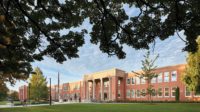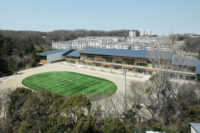Eighty-five percent of the Arlington Elementary School’s 276 students were eligible for free or subsidized breakfasts and lunches when Seattle-based Mahlum was hired to design a replacement for its aging facility in Tacoma. So the architects put meals center stage in the new building. Just steps beyond the reception desk, a flexible cafeteria cum activities space has an adjacent kitchen—fully visible through floor-to-ceiling glass walls—with three doors: two for whole classes to file through to pick up their meal trays, the third a less visible “shortcut” for kids craving seconds.
Additional Content:
Jump to credits & specifications
This unconventional arrangement is barely noticeable in a school so fluid and transparent that it appears to have more windows and sliding glass doors than opaque walls. But Arlington is not open-plan. At the start of design, school principal Wendy Pye-Carter flatly rejected that trend. Instead, the public school would be better described as open-program, an experiment unleashed by Tacoma Public Schools’ 2014 radical rethink of elementary school design, titled A New Vision for the Elementary Learning Environment. Four years earlier, the city’s schools hit a troubling 55 percent high school–graduation rate, motivating a group of forward-thinking state lawmakers to step in. The legislators identified the district as an “Innovation Zone” and introduced a $500 million bond to build 14 new schools, 10 of them elementary, that voters approved. Arlington Elementary is the first ground-up school designed with this vision, which embraces values—connecting to nature, food, and the community; using natural light and the emotional impact of color—over specifications. The goal: to create lifelong “learning-scapes” for study, whether that be project-based, collaborative, or self-directed.
Mahlum, a firm responsible for more than 100 newly constructed or renovated school projects across the Pacific Northwest, embraced the challenge with the vigor of a grad-school thesis studio. “Their vision told us that they wanted us to question everything,” says firm principal JoAnn Wilcox. Shaped by conversations with teachers, adult community members, and students, the design reflects that exploration.
Wilcox and coprincipal Corrie Rosen developed a stick-framed quarter-scale model with movable walls and furniture, then invited the teachers to arrange the elements into “lesson plans” rather than architecture. At first, they kept shaping traditional classrooms, but soon the game loosened boundaries. A simple pattern of repeating and interlocking spaces emerged: a 540-square-foot core instruction room bracketed by larger, 1,080-square-foot project labs, a small 180-square-foot group room, a 3,000-square-foot shared-learning space, and an outdoor learning area that could range from 3,000 to 6,000 square feet. “Every space is a teaching space with layers of choice, focused to messy,” says Wilcox.
In plan, the building comprises a central core with four wings reaching outward—outdoor learning spaces abutting or in between them. The facade is brick, predominantly yellow but broken up with a glazed orange pattern and punctuated by orange and red window frames, all topped by simple, lightly patterned white, textured metal fascia. The community picked the colors to symbolize “transcendence.” Perimeter gates and screens are made of weathering steel, laser-cut in patterns that suggest, among other things, butterflies emerging from flowers.
According to Wilcox, the modest budget of $283 per square foot was an asset, forcing the design team to organize the interior spaces into a rigorous grid easily constructed from modular wood framing spanned by deep truss joists. Perimeter activity areas have lower, 8-foot-2-inch ceilings set by standard door heights, but they link to the outdoors with generous floor-to-ceiling glazing. Though distant from exterior windows, smaller core instruction spaces and some central common areas soar, with 20-foot-high north-facing sawtooth clerestories that bathe them in daylight. The modest structural system and use of such thrifty interior materials as acoustical ceiling tiles and felt wall panels, left room in the budget for the sliding-glass doors, all exterior- and acoustically rated, which both connect and separate every space with one-finger glide and click. “The doors couldn’t be an event,” says Wilcox. “They couldn’t take more than two seconds to move, and they had to be wide enough to create an extension of the teaching space.”
At the northeast corner, the main entrance unfolds in a procession that smoothly facilitates principal Pye-Carter’s morning ritual of teachers and community volunteers greeting each student, with everyone (often including family members) gathering in the gym. Together, they recite two pledges, one to the country, the other to personal values: to be courageous, resilient, victorious. The values appear on walls and windows throughout the school.
Memories of the now demolished former school drove key decisions. Outside, a playground—the result of brainstorming with the students—determined the building’s site atop a hill the kids long enjoyed rolling down, now enhanced with a quartet of slides. The old school’s exterior nooks and crannies were havens for drug dealers, yet the community still wanted what they called a “front porch” for the new school, which sits on the same site. Mahlum responded by carving an outdoor play area out of the ground floor, facing the neighborhood, boldly washing its surfaces in a brilliant persimmon to help draw the policing eyes from the street.
The building’s effect on learning can’t yet be measured, according to Pye-Carter (though the district’s overall efforts have boosted graduation rates above 80 percent). The school’s adaptability proved valuable as redrawn district boundaries dramatically boosted Arlington’s student population to 450. The fluid spaces have been a test. “More established teachers,” as Pye-Carter carefully puts it, “still feel the need for control. Younger teachers have less trouble just letting the kids go.” Students with behavioral issues don’t always thrive. “We have some busy kids,” she says. “The openness provides an audience.”
Though intimately involved in every step of the design, Pye-Carter says she didn’t like all the transparency her first year until she, too, discovered the value of an audience. By year two, she’s come to love the glass. “I can see everything,” she says, “and I can bother the kids without the teacher knowing—y’know, give them a thumbs-up.”
CreditsArchitect: Mahlum 71 Columbia St Floor 4 Seattle, WA 98104 206-441-4151 www.mahlum.com
Personnel in architect's firm who should receive special credit: David Mount AIA LEED AP, JoAnn Hindmarsh Wilcox AIA LEED AP, Corrie Rosen AIA LEED AP, Karen Wood AIA LEED AP, Royce Bixby AIA LEED AP, Laura Poulin, Dwayne Epp AIA CSI CDT LEED AP
Engineers: Structural: Coughlin Porter Lundeen Civil: AHBL, Inc. Electrical: BCE Engineers Mechanical: Metrix Engineers
Consultants: Landscape Architect: AHBL, Inc. Cost Estimator: The Robinson Company Food Service: Halliday Associates Acoustical: A3 Acoustics Hardware Consultant: Adams Consulting
General contractor: Neeley Construction
Photographer: Benjamin Benschneider |
SpecificationsExterior Cladding Masonry: Interstate Brick (Light Brick), Elgin Butler (Glazed Brick) Metal panels: Morin (Concealed Fastener System), Architectural Sheet Metal (Weathering Steel Fabrication) Metal/glass curtain wall: EFCO Moisture barrier: VaproShield
Roofing Elastomeric: Sika Sarnafil
Glazing Glass: Hartung Skylights: Bristollite Daylighting Systems
Doors Entrances: Pempco Metal doors: Curries Steel Doors Fire-control doors, security grilles: The Cookson Company (security grilles) Special doors: Fleetwood (multi panel glass sliders)
Hardware Locksets: Von Duprin Closers: Horton Automatics Exit devices: Von Duprin Pulls: Von Duprin Security devices: Von Duprin
Interior Finishes Acoustical ceilings: Rockfon Suspension grid: Rockfon Demountable partitions: Advanced Equipment Cabinetwork and custom woodwork: Genothen Paints and stains: Rodda Wall coverings: FSorb Plastic laminate: Formica, Nevamar, Wilsonart, Pionite Solid surfacing: Samsung Floor and wall tile: Dal Tile Resilient flooring: Forbo Carpet: Shaw Contract
Lighting Interior ambient lighting: Betacalco Downlights: Betacalco Exterior: Philips
Plumbing Sinks: Elkay Faucets: Chicago Faucets Water closets: Sloan Drinking fountain with Bottle Filling Station: Elkay |












Post a comment to this article
Report Abusive Comment